|
In 1955, as with today, if you
want to see some of the most amazing aeroplane models - especially very large
scale and/or unusual craft - look to Germany. The 1956
Air Trails magazine Annual Edition reported on the World Championships in
Germany for the International Wakefield Cup, F.A.I Free Flight, and Nordic A/2
Glider events. The three '55 World Championships were held in September at the
U.S. Air Force's Finthen Airfield, near Wiesbaden,
Germany. Competition was fierce amongst European and American contenders. There
were no control line or radio control events at this meeting. It is worthwhile
to remember that 1955 was a mere eleven years after the end of World War II, and
that former foes were gathered together for a sporting contest. There could
easily have been men there who, without knowing it, were competing against
military adversaries they met on the battlefield or in occupied towns a decade
earlier.
World Championships in Germany

Wakefield Cup - Total surface area 263.5-294.5 sq. in.; min.
total weight 8.113 0z.; max. rubber weight 2.821 oz.
Free Flight Gas - Min. total weight 115.6 oz. per cu. in. capacity,
max. engine capacity .1525 cu. in.; max. motor run 15 sec.; min. surface loading
3.93 oz. per sq. ft.
Nordic Glider - Total surface area 495.9-526.9 sq. in.; min.
weight 14.460 oz.
Championships Model Specifications
Biggest thing that ever happened in International contest flying was the 3-event
'55 World Championships, held in Western Germany last September 3-5. Host was the
USAF, who flew over the American teams, AMA Pres. Keith Storey and other contest
officials from New York.
Never before have so many of the globe's top flyers gathered together at one
Internationals - there being 80 in A/2 (Nordic) Glider; 74 in F.A.I. F/F Power and
70 in Wakefield, making a grand total of 224 from 23 countries. Top figures prior
to this were 158 from 20 countries, at '53 meetings held in Britain (Wakefield &
F/F) and Yugoslavia (A/2).
But it was not just sheer size that made the '55 Championships outstanding. In
Wakefield, there were 7 men tying for first place - the fly-off being won by Gustav Samann of Germany; in F/F Gas, 3 tied with maximum scores - Britain's Michael Gaster
winning this one; in Nordic, Germany again triumphed when '54 winner Rudolf Lindner
took first with a total just 4 seconds short of the possible maximum of 900 seconds.
Team event wins went to Sweden in Wakefield, Britain in Power and Italy in Glider.

Winner - by Michael Gaster of Great Britain. Age 23, built first
model in 1941. Holds British Class C F/F record. Design developed over long period
of contest flying (winning version was 14th). Powered by Oliver Tiger 2.43, this
VTO model spans 52-1/2". Unusual feature: 1/32" dia. turbulators cemented to wing and
stab 3/16" behind L. E.'s "Modelspan" covered, 5 coats dope, 2 of thinned banana
oil. Right/right trim.

F/F Power winner Michael Gaster of Britain and his graceful Oliver
Tiger diesel powered design. Ship was 14th of type he's built. In gas majority followed
U.S. trend.
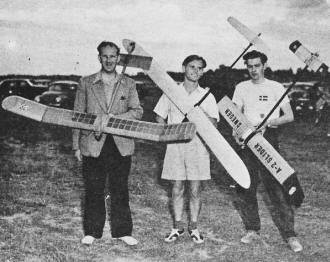
Top three in Gliders. Winner: Rudolf Lindner (Germany) in center
with his latest model. which he did not fly in contest. Second: Bob Gilroy (Gt.
Britain) at left. Third: Rolf Haqel (Sweden).

Top team performance in Wakefield was by these three Swedish
flyers (from left): Hukansson (who placed 2nd), Blomquist (8th) and Ahman (S·10th).
Missing is Johansson (27th).
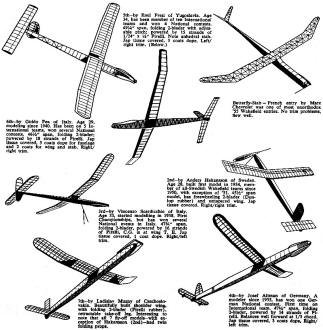
5th-by Emil Fresl of Yugoslavia. Age 34, has been member of ten
International teams and won 4 National contests. 49'4" span, folding 2-blader with
adjustable pitch; powered by 15 strands of 1/24" x 1/4" Pirelli. Note anhedral stab.
Jap tissue covered, 3 coats dope. Left/right trim. (Below.)
Butterfly-Stab - French entry by Marc Chevrolet was one of most
unorthodox '55 Wakefield entries. No trim problems, flew well.
6th - by Guido Fea of Italy. Age 29, modeling since 1940. Has
been on 5 International teams, won several National contests. 46-1/2" span, folding
2-blader; powered by 18 strands of Pirelli, Jap tissue covered, 5 coats dope for
fuselage and 2 coats for wing and stab. Right/right trim.
2nd - by Anders Hakansson of Sweden. Age 28, built first model
in 1934, member of all-Swedish Wakefield teams since 1950, with exception of '51.
45-1/2" span model, has freewheeling 2-blader (Dunlop rubber) and untapered wing.
Jap tissue covered. Right/right trim.
3rd - by Vincenzo Scardicchio of Italy. Age 33, started modeling
in 1938. First Championships, but has won several National events in Italy. 47-3/4"
span, folding 2-blader, powered by 16 strands of Pirelli, C.G. is at wing T. E.
Jap tissue covered, 1 coat dope. Right/left trim.
4th - by Josef Altman of Germany. A modeler since 1935, has won
one German National contest. First time on International team. 47'4" span, folding
2-blader, powered by 14 strands of Pirelll. Balances well forward at 1/3 chord.
Jap tissue covered, 3 coats dope, Right/left trim.
Top U.S. places were 7th in A/2 by Herbert Kothe, 9th in F /F Gas by Otis Goss
and team manager Bob Champine's 11/12th in Wakefield. In team results, U. S. made
3'rd in Rubber, 5th in Gas and 14th in Glider. Worth mentioning: at end of 3rd round
in Wakefield, all U.S. team members had three 180 sec. maximums to their credit!
The three events were flown off at Finthen Airfield, near Wiesbaden, on separate
days-each of the five (2-hour) rounds being split into 4 quarters, during which
only one member of each team could fly. The 180 second "maximum" proved too Iowa
figure, since 38% of all flights recorded (411 out of 1068) were maximums! Hence
the fly-off in Wakefield and Power (and almost in Glider).

Winner - by Rudolf Lindner of Germany. Also flew In '53 and '54
A/2 Championships, winning latter with similar model Began building back in 1942.
Model spans 74-1/4".
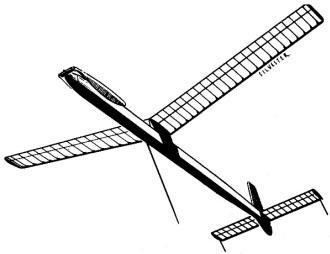
Winner - by Gustav Samann of Germany. Age 33, building since
1933. Member of 5 previous International teams. Design has won many German contests,
including 3 Nats. Span is 49-3/4".

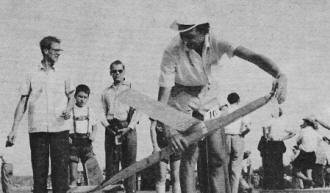
Wakefield winner Gustav Samann of Germany and his folding prop,
"V" dihedral design. Note very steep take-off angle - compromise with VTO.

U.S. Wakefield team was 3rd. Lt. to rt.: Herbert Kothe (13th):
Gene Schapp (20th); Manuel Andrade (l8th) and team manager Bob Champine (front)
who did best with 11/12th.

U.S. F/F Power team had widely assorted models, but all Torp .15 powered. Lt.
to rt. from back are: Bill Hartin: team manager Bob Champine: Ernie Shailor: Harry
Gould and Otis GOBS.
Third man in fly-off in F/F Power, was Canada's Bryant Jones, who also used Oliver
Tiqer diesel like winner Gaster. Neat simple ship featured high aspect ratio wing
and stab.
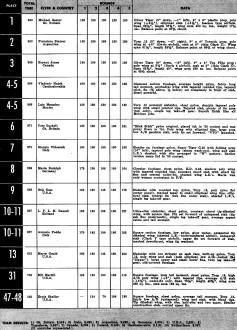
2nd (below-by Francisco Stajcer of Argentina. Simple straight-forward (but rather
bulky) slabsider pylon, powered by Torp .15 (8" x 4" Tornado prop), with multi-spar
wing and stab. Span 51~". Entire model silk covered, 6 coats of dope. Right/left
trim.
Forward-fin VTO Austrian design (right) by Oskar Czepa was powered by E. D. 2.46,
first seen at '53 Championships in England.
Marla Rudolph was only woman free flight contestant to fly. She placed in 8th
for Germany, with this E.D. 2.46 twin-finned pylon. German team was 5th.
Scimuel Davila of Mexico placed 22nd with this unusual forward-fin F/F entry.
Plenty of unorthodox ships flown at '55 Championships with VTO take-offs a common
sight.
High-thrust line Australian entry (left) by Bond Baker had beautifully clean
lines, "fish-tall" stab fins and wing tip fins.
 3rd-by Bryant Jones of Canada. Member of
Avro model club. Holds Canadian Class B F/F and A speed records. Many different-size
versions of some basic design built. Powered by tuned Oliver Tiger, span 65-1/2".
"Skysail" covered. 4 coats dope, 1 of fuel proofer. Right/right. 3rd-by Bryant Jones of Canada. Member of
Avro model club. Holds Canadian Class B F/F and A speed records. Many different-size
versions of some basic design built. Powered by tuned Oliver Tiger, span 65-1/2".
"Skysail" covered. 4 coats dope, 1 of fuel proofer. Right/right.
German winner Rudolf Lindner (top, left) and his sleek pod and boom design. He
won last year with similar model, using same pair of wings. (top, right):
Italy won team crown-highest scorer was Enzo Giusti (hiding at left!). Enzo flew
another model in contest - without tip fins. Swedish team was 2nd, France 3rd and
U.S.A. 14th. Herb Kothe (lower, left) was top scoring man in U.S. glider team, with
7th. Others in team were well down list, U.S.A. did best in F/F and
Wakefield. (lower, right): Italian flyer Enzo Giusti was just 10 seconds behind
winner, which gave him 4th. Design was one of many unorthodox entries.
3rd - by Rolf Hagel of Sweden. Age 20, modeling since 1949. Member of 1 previous
A/2 team and 3 power teams. Design is 77" span, has hardwood wing spars, Gott. 417
wing airfoil and thin undercambered stab airfoil.
2nd - by Bob Gilroy of Gt. Britain. Age 34, started modeling in 1937. 71" span
design has Hansen wing airfoil (spruce spars) and. Hacklinger stab airfoil. Unusual
feature: stubby H4" nose for quick stall recovery. Modelspan tissue, with two coats
of dope. Circles left.
Tip-Finned pylon stick A/2 glider entry by Laslo Pinter of Yugoslavia made possible
complete elimination of dihedral.
Forward-fin model by Britain's John O'Donnell of Wakefield fame, performed well;
placed 19th in '53 Championships.
|


